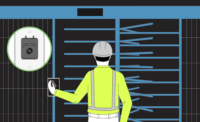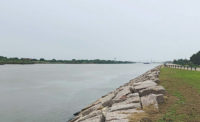Managing jobsites with dozens or hundreds of workers can be a headache for site supervisors, and getting workers to report every small injury or safety incident is a challenge for safety managers. To meet this need, Triax Technologies, Norwalk, Conn., has launched Spot-R, a small, belt-mounted sensor that automates safety reporting on the jobsite.
A construction worker wears the discreet sensor unit on a belt clip, and a wireless system tracks their movements and logs their activity data, similar to popular fitness-tracking wearable devices. But the Spot-R is able to track more than jogging, using an accelerometer, gyroscope and altimeter to instantly recognize when and where a worker has fallen or stumbled.
“We look at a combination of data coming off all those sensors to re-create a trip-and-fall,” says Chad Hollingsworth, cofounder of Triax. “We can tell how high they fell from, what direction and how hard they landed.”
The device can provide real-time notification of hazards and injuries, allowing safety managers and site supervisors to know where and when an incident has occurred. Alerts can be set up so that they are instantly notified, and the system logs all the relevant data in the cloud.
The Spot-R system uses a proprietary wireless mesh network to both report incidents and locate workers within the site. According to Hollingsworth, the system works above the 900-MHz radio band, allowing for some penetration of concrete walls and relatively few base stations to maintain connections. The 2-oz. unit reports back to the network every 10 seconds and shuts off when it leaves the jobsite. The sensor unit has a battery life of one year. A base-station “pod” requires an external power source, but relay boosters boast a one-year battery life. Roughly 12 fixed sensors are needed for a typical three-story building.
The belt unit’s altimeter has a 1-ft vertical accuracy, and the mesh network is capable of 20 ft of horizontal accuracy. “We found that, for many customers, that was enough. We don’t need to know what chair the worker was sitting in, just the zone of the site,” says Hollingsworth. The technology originally was developed to track injuries in sports players, and Hollingsworth says that, when they first brought the solution to the construction industry, the location data was an afterthought. “We didn’t realize until we were on sites that telling who is where still isn’t done efficiently. It became a natural approach from the safety incident data we were already collecting,” he says.
Spot-R’s desktop and mobile applications provide data on location histories, hours worked on site, injury alerts and live monitoring of worker locations. The mesh network uploads the data to the cloud over a cellular connection, allowing off-site managers to monitor jobsites in real time. “The safety manager can see what his guys are doing, while a sub can just see his crew. Meanwhile, someone at corporate headquarters can monitor 20 jobs at once,” says Hollingsworth.
In the system, each safety incident includes the worker’s name and the location of the incident, as well as the type and severity of the injury. Then, the data can be compiled into safety reports. Currently, the data cannot be easily exported into project management software, but Triax is working to improve integration.
While Spot-R became commercially available only in the fourth quarter of 2016, Hollingsworth says a year-long beta test with in-the-field contractors has been very productive. “Our ultimate goal is to reduce insurance premiums. Now, we’re building this critical mass of data and can make the case to carriers,” he notes.






Post a comment to this article
Report Abusive Comment